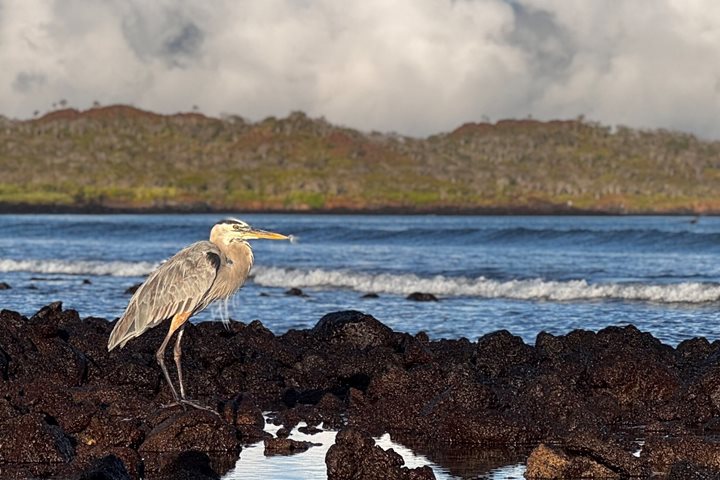Very early this morning, before sunrise, the National Geographic Endeavour sailed northwards across the Equatorial Line, on its way to the anchorage at Darwin Bay in Genovesa Island. As the first light of the day shone on the tranquil bay, Captain Fausto Hinojosa skillfully navigated the narrow deep water channel that leads to the only suitable anchorage within a magnificent collapsed crater that has opened to the ocean in recent geological times.
Our plan for the day was to explore the great seabird breeding grounds, which are an ever temporary home to more than a quarter of a million nesting pairs of great frigatebirds, red-footed boobies, Nazca boobies, and many others.
After breakfast, our guests were ready for action. We broke up into two landing parties so as to minimize the impact on the only two visitor sites that Genovesa has to offer. Despite being one of the smallest islands in the archipelago, the sight of being within this magnificent crater makes for an awe-inspiring impression. Genovesa is no exception to the fact that about 96% of the Galapagos National Park is completely inaccessible to guests, with visitor sites making up less than 1% of the whole landmass of this island group.
Aboard our Zodiacs, we explored the coastline as we transited towards the landings, observing seabirds and even resting Galapagos fur seals that lied peacefully in crevices sheltered from the stinging morning sun.
Our party that landed at the small coralline beach within the bay, where we were greeted by a few lazy Galapagos sea lions, as the occasional red-footed booby furiously ripped some salt bush branches off the beach head just behind the landing. The red mangroves farther inland where bustling with activity as red-footed boobies diligently delivered materials to their nest-building partners.
Our last excursions included snorkeling and a kayaking opportunity along the steep cliffs of the inside of the bay, and the experience was equally rewarding both above and below the waves. Tropical fish like moorish idols feel at home in the always warmer waters of the northern end of the archipelago, as other more numerous fish have to quickly dive to evade the seabirds that elegantly plunge in after them. Above the waves, large numbers of frigatebirds soared on the thermals as they kept an eye out for any successful plunge dives by the other sea birds, with the intentions of stealing the fish from them. Frigatebirds are known as pirates of the air, after all!
In the afternoon, we landed on the Prince Phillip Steps, where the beautiful flat light gave us excellent opportunities to photograph our endemic sub-species of short-eared owl. This owl is unusual, in that it is predominantly active during the day, in the absence of the threatening Galapagos hawk which found on so many of the other islands.
As the sun neared the horizon we crossed the bay once again, returning to the National Geographic Endeavour, which was ready to heave anchor and leave the bay through the narrow passage with last light.
As I write these closing words for today’s Expedition Reports, we are once again nearing the equator as our ship makes its way to Aeolian Bay on Baltra Island.









